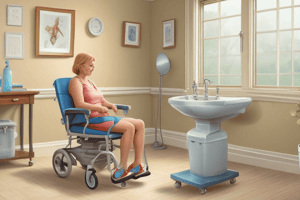Podcast
Questions and Answers
What primarily causes stress incontinence?
What primarily causes stress incontinence?
- Weakened pelvic floor muscles (correct)
- Overactive bladder
- Detruser muscle hyperactivity
- Bladder outlet obstruction
Which of the following conditions can lead to urgency incontinence?
Which of the following conditions can lead to urgency incontinence?
- Parkinsonism (correct)
- Underactive bladder
- Abdominal obesity
- Bladder outlet obstruction
In which type of incontinence is urine leakage primarily caused by a distended bladder?
In which type of incontinence is urine leakage primarily caused by a distended bladder?
- Functional incontinence
- Mixed incontinence
- Stress incontinence
- Retention/overflow incontinence (correct)
What is the defining characteristic of functional incontinence?
What is the defining characteristic of functional incontinence?
Which medication is commonly used to treat overactive bladder symptoms?
Which medication is commonly used to treat overactive bladder symptoms?
Flashcards are hidden until you start studying
Study Notes
Types of Urinary Incontinence
- Stress Incontinence: Most common type, linked to weakened pelvic floor muscles.
- Weakened muscles lead to urethral and bladder-neck mobility issues, causing incompetence of the urethral sphincter.
- Increased intra-abdominal pressure from activities like laughing, coughing, or exercise exacerbates the condition.
- Abdominal obesity contributes to higher pressure in the bladder, leading to urine leakage when sphincter fails to close.
Urgency Incontinence/Overactive Bladder (OAB)
- Characterized by leakage of moderate to large amounts of urine without the ability to delay voiding.
- Primary causes include detrusor muscle hyperactivity or instability, along with central nervous system disorders such as Parkinson's, stroke, spinal cord injury, and multiple sclerosis.
- Certain cholinergic medications can also be a contributing factor.
Retention/Overflow Incontinence
- Occurs when urine leaks due to a distended bladder, typically caused by an underactive detrusor muscle.
- Common underlying conditions include diabetes, stroke, or bladder outlet obstruction, such as benign prostatic hyperplasia (BPH).
- The pressure inside the bladder surpasses the resistance at the urinary outlet, leading to leakage.
- More frequently observed in males.
Mixed Incontinence
- This type typically presents symptoms of both urge and stress incontinence.
Functional Incontinence
- Defined as urine loss due to inability to reach or use the toilet, not related to lower urinary tract changes.
- Often a result of physical constraints affecting mobility.
Treatment Options
- Anticholinergic medications and antispasmodics are commonly used for treatment.
- Muscarinic antagonists include Oxybutynin, Tolterodine, Darifenacin, Solifenacin, Fesoterodine, and Trospium.
- These medications help manage symptoms and improve quality of life for individuals with various types of incontinence.
Studying That Suits You
Use AI to generate personalized quizzes and flashcards to suit your learning preferences.





